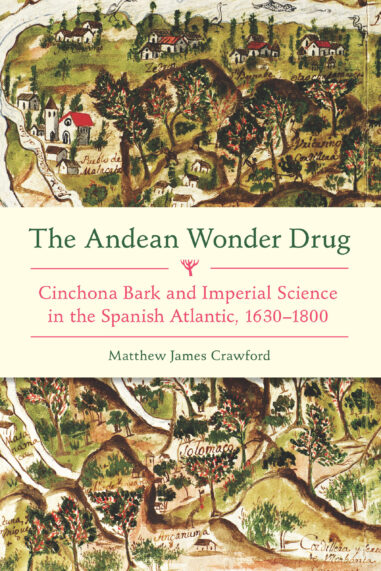The Andean Wonder Drug
Cinchona Bark and Imperial Science in the Spanish Atlantic, 1630-1800
Excellently thought out and clearly written. An excellent book.
Request Exam or Desk Copy. Request Review Copy
In the eighteenth century, malaria was a prevalent and deadly disease, and the only effective treatment was found in the Andean forests of Spanish America: a medicinal bark harvested from cinchona trees that would later give rise to the antimalarial drug quinine. In 1751, the Spanish Crown asserted control over the production and distribution of this medicament by establishing a royal reserve of “fever trees” in Quito. Through this pilot project, the Crown pursued a new vision of imperialism informed by science and invigorated through commerce. But ultimately this project failed, much like the broader imperial reforms that it represented. Drawing on extensive archival research, Matthew Crawford explains why, showing how indigenous healers, laborers, merchants, colonial officials, and creole elites contested European science and thwarted imperial reform by asserting their authority to speak for the natural world. The Andean Wonder Drug uses the story of cinchona bark to demonstrate how the imperial politics of knowledge in the Spanish Atlantic ultimately undermined efforts to transform European science into a tool of empire.
More Praise
Crawford's scholarly study adds to our knowledge of the history of cinchona and of the Enlightenment, but probably its greatest contribution is to document in detail the relationship between science and empire through showing how knowledge was actually acquired and disseminated on the ground within specific economic and political contexts. It is a model for future studies of this kind and a significant contribution to understanding the nature of early modern science.
The Andean Wonder Drug is a deft, solidly documented monograph, and anyone with an interest in Iberian "economy botany" is well advised to read it.
Boldly challenges historiographical consensus. Crawford offers a sweeping counternarrative to any simplified account of the rise of scientific modernity as a tool of empire . . . Crawford's illuminating analysis shows that science and knowledge never worked as an outside, adjudicating arbiter.
This book is an impressive contribution to existing scholarship on early modern science and medicine. It enhances our understanding of the acquisition and circulation of knowledge and is a valuable component of the ongoing discussion regarding the effectiveness of European science as a tool of empire.
Crawford is able to weave together a richly detailed and compelling narrative about the politics of natural knowledge in the Spanish Atlantic World, one in which European metropolitan science does not emerge as a privileged way of knowing.
In this compact volume, Crawford brings together a remarkable array of primary sources, including many previously overlooked late eighteenth-century materials. In the process, he reveals how traditional Andean healers, labourers who harvested the bark, elite creole merchants, European explorers and travelers, Royal pharmacists, scientists and medical practitioners - through their various perspectives and specialized knowledge - all contributed to the epistemic understanding of cinchona. . . . Crawford compellingly illuminates the interconnections, as well as the fault lines, among science, commerce, and empire.
. . . this is a remarkable first book by a young teacher-scholar with impressive expository skills and a mature critical arsenal.
The Andean Wonder Drug is an illuminating study of the Spanish Empire's efforts to secure monopoly control over the cinchona tree and its bark. The project ultimately failed, but Crawford's deft analysis offers fresh perspectives into the intimate relationship between early modern sciences and empires, local and global knowledge, and the agents involved in the production of knowledge about quina within the early modern Spanish Atlantic World. At its core, this meticulous analysis is a studied reflection on the question of 'who speaks for nature?'
Crawford's expert account of the Spanish Empire's struggles to control the cinchona tree and its bark reveals profound links between science, politics, and knowledge production in the Atlantic World. This book is an impressive contribution to existing scholarship on early modern science, early modern Spain, and Atlantic World history. Very interesting, well documented, and fun to read.
Crawford's work makes several important contributions to the history of science and to the history of Spain and its empire. Meticulously researched in archives in both Spain and Ecuador, The Andean Wonder Drug provides a thought-provoking cultural history of a highly prized botanical commodity. It will be of interest to historians of eighteenth-century Spain and historians of early modern science and represents a valuable contribution to both fields.
The Andean Wonder Drug is a tour de force in revealing the bureaucratic nature of the production of knowledge in the early modern Atlantic world through the "eyes" of an essential, yet contested, drug. Quina and cinchona will never be viewed the same again.
336 Pages, 6 x 9 in.
May, 2016
isbn : 9780822944522
Subjects
about the author


Matthew James Crawford is associate professor in the Department of History at Kent State University and author of The Andean Wonder Drug: Cinchona Bark and Imperial Science in the Spanish Atlantic, 1630–1800.
learn more


